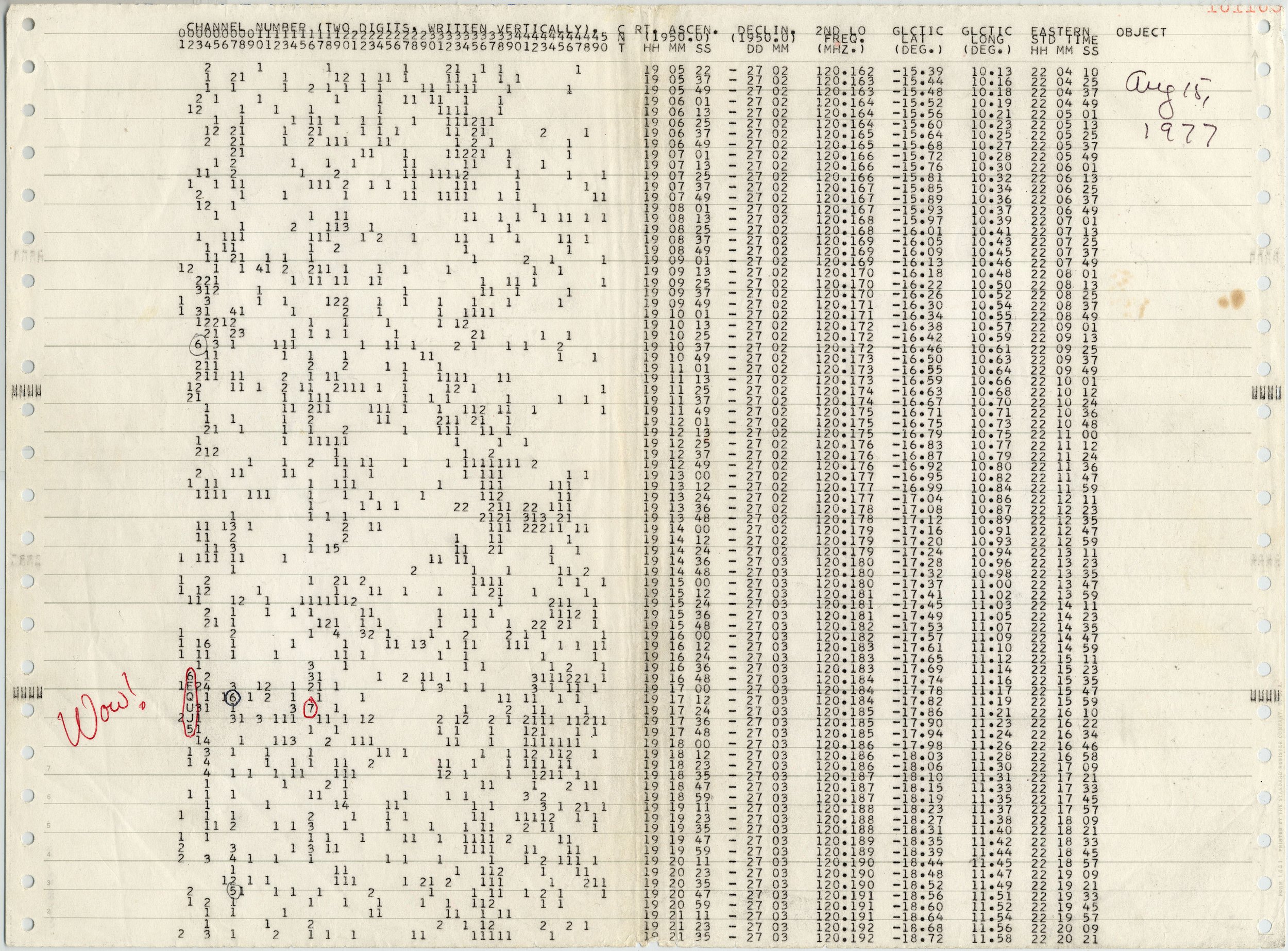
The Wow! Signal
August 15, 1977
Ohio State University’s Big Ear Radio Telescope
Hello?
6EQUJ5 says it all. The data, primarily 1s, 2s and 3s, indicate weak background noise. Letters, especially those closer to the end of the alphabet, represent stronger signals. The “6EQUJ5” is read from top to bottom (see graph below) and shows the signal rising from “6” to “U” before dropping back down to “5”.
The Big Ear Observatory, on the grounds of Ohio Wesleyan University, operated from 1963-1998. The observatory was torn down in 1998 to make room for a golf course. Credit: Bigear.org / NAAPO
On August 15, 1977, astronomer Jerry R. Ehman made history while working with the Big Ear radio telescope at Ohio State University. As part of a project searching for extraterrestrial intelligence (SETI), the telescope was scanning the skies for narrowband radio signals—frequencies often associated with artificial sources, as they are not typically produced by natural celestial phenomena. What Ehman found that day was extraordinary: a 72-second signal, remarkably strong and confined to a narrow frequency band. On reviewing the computer printout, he circled the data in red ink and wrote a single word in the margin: “Wow!”
Plot of signal strength vs time of the Wow! signal. The signal rose and fell during the 72 seconds observation window. Credit: Maksim Rossomakhin
At the time, comets 266P/Christensen and 335P/Gibbs would have both been just south of Chi Sagittarii where the signal was received. Diagram: Bob King, source: Stellarium
The "Wow! Signal," as it became known, originated from the direction of the constellation Sagittarius, near the Chi Sagittarii star group. The signal’s intensity and frequency—approximately 1420 MHz—were particularly intriguing. This frequency is associated with the hydrogen line, a natural radio emission from neutral hydrogen atoms, which many astronomers believe would be an ideal channel for interstellar communication due to its universality. Despite extensive follow-up efforts, the signal was never detected again, making it a true "one-hit wonder" in the search for extraterrestrial intelligence.
The Wow! Signal’s significance lies in its rarity and potential implications. It stands out as one of the strongest candidates for an extraterrestrial message ever recorded, fueling speculation and debate among scientists and enthusiasts alike. While many natural explanations have been proposed, including interstellar scintillation or emissions from comets, none have been definitively proven. This ambiguity has left the Wow! Signal suspended in a liminal space between scientific curiosity and cosmic mystery.
From a scientific perspective, the signal underscores the importance of SETI and the challenges inherent in the search for extraterrestrial life. The ephemeral nature of the Wow! Signal highlights the difficulties in identifying and verifying potential messages from other civilizations. For SETI researchers, it serves as both a tantalizing clue and a frustrating reminder of the limitations of current technology and observational methods.
Culturally, the Wow! Signal has achieved legendary status. It symbolizes humanity's enduring curiosity about our place in the universe and the possibility of life beyond Earth. It has inspired books, documentaries, and even fictional works exploring what such a signal might mean. The handwritten “Wow!” annotation has become an icon of scientific wonder, capturing the excitement of discovery and the human desire to connect with the unknown.
Today, the Wow! Signal remains a puzzle. Its fleeting nature ensures that it cannot serve as conclusive evidence of extraterrestrial life, but it continues to inspire scientific inquiry and public fascination. Advances in technology, such as more sensitive radio telescopes and artificial intelligence for signal analysis, offer hope that we may one day detect a similar event—this time with the means to study it more thoroughly.

